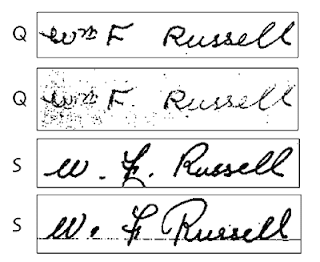The History of Forensic Handwriting Analysis
In the 19th century, a French scholar named Abbe Jean Michon studied the different letter forms used by writers, and coined the term "graphology." Alfred Binet and Milton Bunder were also important in the development of handwriting analysis, but it was Sir William Herschel who supported using handwriting analysis as an investigation tool. Herschel also developed the science of fingerprint analysis.
Several famous criminal investigations have involved handwriting analysis. A few of these are the Lindbergh baby kidnapping in the 1930's, the "Unabomber" Ted Kaczynski's case, and the JonBenet Ramsey murder case.
Handwriting analysis is known by many names, including forensic document examination, document examination, and handwriting examination. The term handwriting analysis is not often used, as it may be confused with graphology, which uses handwriting to study the human psychology. A forensic document examiner is not the same as a graphologist.
A forensic handwriting analysis is done to decide the authenticity of a handwritten signature or document. Large police departments and the FBI have professional handwriting analysts working for them.
In the 19th century, a French scholar named Abbe Jean Michon studied the different letter forms used by writers, and coined the term "graphology." Alfred Binet and Milton Bunder were also important in the development of handwriting analysis, but it was Sir William Herschel who supported using handwriting analysis as an investigation tool. Herschel also developed the science of fingerprint analysis.
Several famous criminal investigations have involved handwriting analysis. A few of these are the Lindbergh baby kidnapping in the 1930's, the "Unabomber" Ted Kaczynski's case, and the JonBenet Ramsey murder case.
Handwriting analysis is known by many names, including forensic document examination, document examination, and handwriting examination. The term handwriting analysis is not often used, as it may be confused with graphology, which uses handwriting to study the human psychology. A forensic document examiner is not the same as a graphologist.
A forensic handwriting analysis is done to decide the authenticity of a handwritten signature or document. Large police departments and the FBI have professional handwriting analysts working for them.
12 Characteristics of Writing Styles:
1.) Line Quality: Look at the pen marks. Are they smooth and flowing or shaky and wavering?
2.) Spacing of Words and Letters: Is the spacing between the letters and words wide or narrow? Is it consistent?
3.) Ratio of the relative height, width, and size of letters: What is the ratio? Is it consistent?
4.) Pen lifts and separations: Where are the new letters and words formed? Are pen lifts in unusual places?
5.) Connecting strokes: Are the capital letters connected to the lowercase letters? Are there connecting strokes between letters and words?
6.) Beginning and ending strokes: Are the beginning and ending strokes straight, curled, long, short, upstroke, or downstroke?
7.) Unusual letter formation: Are there any unusual letter formations, such as letters formed backwards, letters with a tail, and unusual capital letters?
8.) Shading or pen pressure: Is the pen pressure on the upward or the downward strokes?
 9.) Slant: Is the slant of the letters left, right, or straight up and down? Is there consistency between the slant of letters.
9.) Slant: Is the slant of the letters left, right, or straight up and down? Is there consistency between the slant of letters.
10.) Baseline habits: Is the writing/letter formation above or below the line?
11.) Flourishes and embellishments: Are there any flourishes or embellishments on the letters? If so, what are they?
12.) Diacritic placement: How are the t's crossed? How are the i's and j's dotted? Are the dots to the right, left, or in the center of the letter?
1.) Line Quality: Look at the pen marks. Are they smooth and flowing or shaky and wavering?
2.) Spacing of Words and Letters: Is the spacing between the letters and words wide or narrow? Is it consistent?
3.) Ratio of the relative height, width, and size of letters: What is the ratio? Is it consistent?
4.) Pen lifts and separations: Where are the new letters and words formed? Are pen lifts in unusual places?
5.) Connecting strokes: Are the capital letters connected to the lowercase letters? Are there connecting strokes between letters and words?
6.) Beginning and ending strokes: Are the beginning and ending strokes straight, curled, long, short, upstroke, or downstroke?
7.) Unusual letter formation: Are there any unusual letter formations, such as letters formed backwards, letters with a tail, and unusual capital letters?
8.) Shading or pen pressure: Is the pen pressure on the upward or the downward strokes?
 9.) Slant: Is the slant of the letters left, right, or straight up and down? Is there consistency between the slant of letters.
9.) Slant: Is the slant of the letters left, right, or straight up and down? Is there consistency between the slant of letters.10.) Baseline habits: Is the writing/letter formation above or below the line?
11.) Flourishes and embellishments: Are there any flourishes or embellishments on the letters? If so, what are they?
12.) Diacritic placement: How are the t's crossed? How are the i's and j's dotted? Are the dots to the right, left, or in the center of the letter?


No comments:
Post a Comment